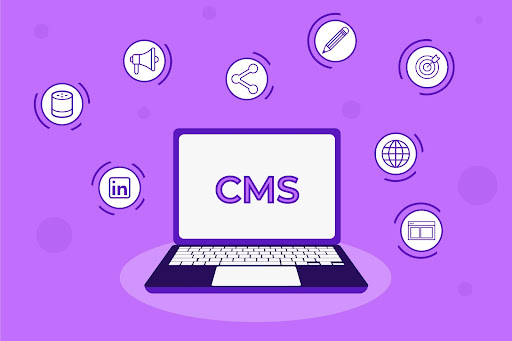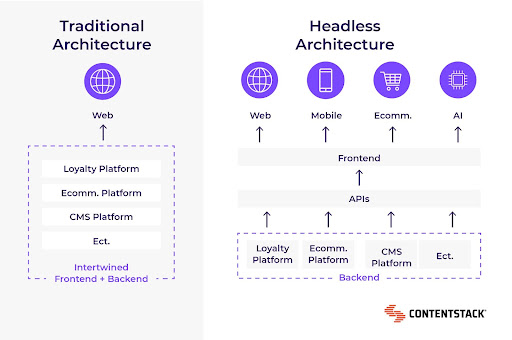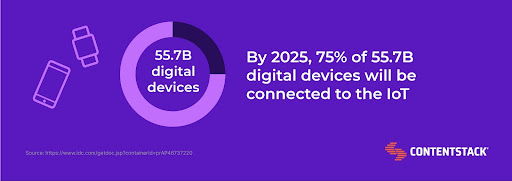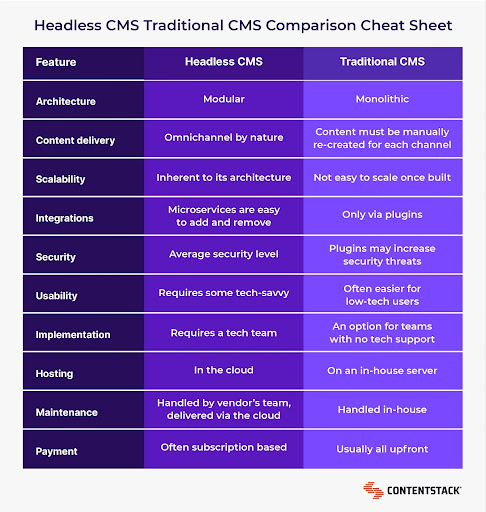If you’re on the hunt for a new content management system, a common term you’ve likely seen is “headless CMS.” In this article, we’ll explain what a “headless” content management system is, how it compares to other content management systems and which might work best for you.

What Is a Content Management System?
A content management system, or CMS, is a software platform that allows business users to create and publish content without needing to understand code. Depending on the CMS, content can be delivered to a website, mobile application or other digital technologies.
CMS platforms are a primary tool for creating and managing content. Many modern CMS solutions come with collaboration and governance features that help control content throughout its lifecycle.
For more background on the development of the CMS, read History of Content Management Systems and Rise of Headless CMS.
Headless CMS vs. Traditional CMS
Today we’re going to talk about two high-level varieties of CMS: the traditional CMS and its modern spinoff, headless CMS.
Here’s what you need to know about each.

The Ins and Outs of Headless CMS
Headless CMS disconnects the back end (aka the “body”) of the platform where content is created, managed and stored from the front end (aka the “head”) of the platform where content is formatted, designed and distributed. Application programming interface (API) technology enables both sides of the platform to communicate and work together as needed – at the same time.
This structure is what makes a headless CMS so flexible and approachable for businesses with heavy and variable content needs. Marketing and content teams can create, manage and store content in reusable modules. At the same time, designers and developers can access the CMS to integrate apps and languages to build cutting-edge workflows that deliver this content to dynamic website pages, smartwatch apps, chatbots and other digital experiences.
Next, we’ll discuss some of the most important features that powerful headless CMS solutions share.
APIs
The application programming interface is a key feature of the headless CMS. Headless CMSes are sometimes called API-first CMSes. Some APIs deliver content to omnichannel digital experiences. Other APIs create communication channels between applications so these tools can work together to optimize modules of content. These applications often contain information about customers or products that, when injected into the content, make it more personalized to the consumer and the situation.
Integration Ability
Thanks to the flexible and loosely connected (via API) structure of headless CMSes, you’re always ready for the next integration.
A headless CMS makes it simple for developers to plug in third-party applications to enrich content. Users often integrate customer relationship management (CRM) platforms, product information management (PIM) software, enterprise resource planning (ERP) tools, marketing automation programs, analytics tools and other applications. These enable marketing teams to create fast, personalized and cohesive content-driven experiences on a large scale.
Content Management Tools
An effective headless CMS should have rich text-editing capabilities, flexible content models and modules, creation and approval workflows, rules and permission settings, content previews, publishing automation and more.
Developer Resources
Headless CMS software should make life as easy for developers as it does for marketers. It should feature development resources such as webhooks, web frameworks, SDKs, easy-to-use APIs, DevOps services, detailed documentation and customer support.
All About Traditional CMS
Traditional content management systems also empower users to create, manage and publish content. The main difference from headless CMSes is that traditional systems are monolithic in structure, meaning the back end and front end are tightly coupled in a single technical area. In this structure, once a content asset has been published, it’s in its final state. In a traditional system, content isn’t stored in modules, making content assets difficult to reformat or reuse. It’s also difficult to add new functionality or features to a traditional CMS as it requires using a plugin versus an integration.
There are some features that monolithic traditional CMSs share.
Monolithic Platform
The core feature of a traditional CMS is a single monolithic platform that feeds content to a website. This architecture makes it an out-of-the-box solution that sacrifices flexibility for ease of use without development support.
Templates + Plugins
Because traditional CMSes were created to deliver content to websites alone, they don’t need much flexibility for serving content. This is why they rely on templates for displaying content. These templates are not easily edited, nor are they meant to be. This structure is ideal for business users but gets complicated quickly if you want to change any features or functionality.
The best users can do to customize their traditional CMS instance is to add plugins. Plugins are pre-made applications that can be added to a traditional CMS. However, they’re more like a Band-Aid than a true integration, as they’re workarounds built to break through the tough shell of the monolith.
Content Management Tools
A traditional CMS is heavily focused on content management features. These can include robust text formatting, digital asset management, version tracking, permissioning, WYSIWYG editors that enable marketers to see how the content they’re creating will appear on the live website and more.
Simplicity for Business Users
Ease of use leads many companies that don’t have development resources to choose a traditional CMS. When a simple, website-based experience is all you’re looking to create, traditional CMS is an easy choice.
What Caused the Split Between Headless CMS vs. Traditional CMS?
Static websites were once the extent of the digital experience. For this purpose, the traditional CMS infrastructure was sufficient.
However, experiences today are anything but static. The internet has brought to life a web of Internet of Things (IoT) devices and digital channels. Consumers using these devices and channels are looking for personalized, cohesive and always-on experiences.
Headless CMS was created to deliver these experiences. Vendors saw a need to make content reusable and connect content management tools companies were already using. Headless CMSes simplify large-scale content creation, optimization, delivery and republishing.

You may need a headless CMS if…
1. Marketing is Currently Managing Several CMS Platforms
With headless CMS options on the market, there is no need for your marketing team to recreate content across different CMS instances. A headless CMS can deliver the content you create to multiple channels at the same time — even those sub-brand and foreign-language websites that you’re manually managing across separate platforms.
2. Omnichannel Publishing is Key to Your Marketing Plan
If omnichannel publishing is central to your marketing efforts, investing in a headless CMS will save everyone time and sanity. The modular structure and integration capabilities of a headless CMS make it easy to create content once, run it through different services (CRM, translation, etc.) or workflows and publish it to multiple channels at the same time.
3. Development is Bottlenecking Marketing
A common problem with monolithic CMSes is that typically only developers or tech-savvy marketing personnel can operate them. That means sometimes creative teams have to wait days or even weeks for tech teams to help them publish or edit content. If you don’t have that kind of time to wait to push campaigns to market, a headless CMS grants instant autonomy to all teams involved.
4. Your Business Website is Central to Your Digital Experience
Interactive digital experiences? Smart ecommerce platform? Real-time content personalization? Monolithic CMSs that operate with templates and a one-way flow of content cannot deliver these types of interactions. If your website is a platform where you strive to build creative new customer-first experiences, you need to build it on a flexible, composable, headless CMS.
5. Enterprise-Level Security is a Must
Organizations that collect consumer data to create personalized experiences, especially ones that do so on an international scale, need to keep that data secure. Thanks to a monolithic structure and plugins, traditional CMSs have a larger attack surface than headless CMSes, where the separated front and back ends shrink opportunities for a security breach.
You May Need A Traditional CMS if…
1. Your Main Priority in a Website Is Usability
If your business’ website hardly needs any personalization, you don’t plan on changing its features or functionality and your biggest priority is that it’s fast and easy for you to add content every once in a while, a traditional CMS is the way to go. With a traditional CMS you’ll get the benefit of templates, built-in content management features and security right out of the box.
2. Access to Development Support Is Limited
Not every organization can or wants to have technology experts on the payroll. Traditional CMSes were intended to cater to low-tech business users, making them a perfect fit in this case.
3. Omnichannel Digital Experiences Are Not Part of Your Business Model
Just like every organization doesn’t need on-call developers, many small businesses also don’t have omnichannel, content-driven experiences built into their marketing plans or business models. If you don’t need all the extra flexibility and integration capabilities that headless CMS platforms include, a traditional CMS might meet your business needs.

If you’d like more research, we have an entire series of content devoted to this topic. We invite you to download any of these complimentary ebooks to keep learning.
Related Articles
Here are other CMS articles we think you'll find useful.
Ultimate Guide to CMS Vol. 1: CMS Comparison and Architectures
In this ebook series vol. 1 of 3, we will discuss the following topics: What is a headless CMS? What is a decoupled CMS? The architectural differences between CMSes.
Read more
The Ultimate Guide to CMS Vol. 2: Content Management Systems Pros and Cons
In this ebook series vol. 2 of 3, we will discuss major advantages and disadvantages of a traditional CMS vs. a headless CMS.
Read more
The Ultimate Guide to CMS Vol. 3: Use Cases for Headless Content Management Systems
In this ebook series vol. 3 of 3, we will cover seven of the most popular use cases for leveraging a headless CMS.
Read more
